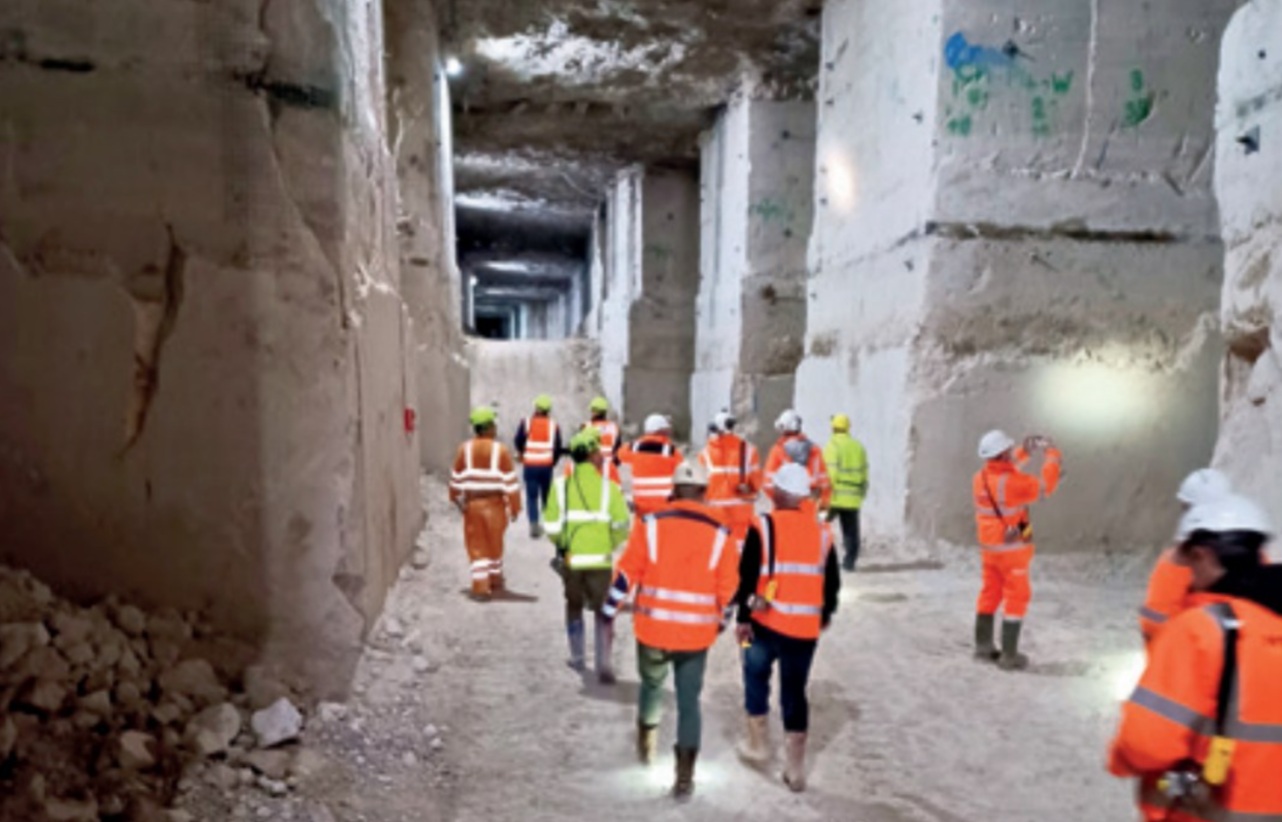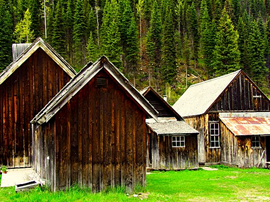Don't take British stone for granted
The UK building stone sector will not survive on supplying the heritage sector alone, and needs the new-build market to provide it with an economically viable future.

|
| Albion Stone’s Jordon Mine on the Isle of Portland. |
The UK has a long and proud tradition of building with dimension stone (natural stone or rock that has been selected and finished to specific sizes or shapes). The diversity of the UK’s geology means that the country is blessed with a variety of stone for building, which has been used in a multitude of ways over the centuries. This diversity defines both the urban and rural landscapes that give us a sense of place.
The accelerated development of the UK’s built environment in the 18th and 19th centuries was underpinned by a geographically spread industry of stone supply, comprising thousands of usually small quarries that supported a very large manual workforce. As shipping developed, and with the arrival of the railways, these quarries started producing massive quantities of hard stone setts, kerbs, steps, walling stone, fine dressed masonry, roofing stone and more.
The variety of geology provided the absolute sense of place in towns and cities across the UK, from the ‘granite city’ of Aberdeen, through the rich red sandstones found in cities like Glasgow and Liverpool, to the magnificent Portland Stone which was used extensively in London alongside a host of other limestones.
A million tonnes of quarried mineral products are transported across the UK every day. The UK minerals industry provides essential raw and processed materials to the construction sector and to other manufacturing industries. The mineral products industry directly employs almost 80,000 people and supports an additional 3.5 million jobs in the economy, with up to 400 million tonnes of aggregates and manufactured mineral products produced annually.
Among the wider minerals extraction industry, a very small part – although still more than one million tonnes per year – is the extraction and manufacture of building stone, also known as dimension stone. But the building stone sector that made the built heritage possible is under threat for a number of reasons. Indeed, those who cherish the use of natural stone in heritage projects, new builds and refurbishments would be unwise to assume its supply.
The threat from imports raises a number of issues. First, buyers are increasingly looking at carbon emissions when sourcing materials, but the playing field is far from level for imported stone and indigenous stone. The carbon produced by stone imported from overseas is not counted until the material reaches land in the UK. This is because the carbon resulting from production, handling and transport belongs to the exporting country until the product reaches the UK border. For example, under current carbon accounting rules, stone imported from China has a lower carbon footprint score than stone produced at a UK quarry just a few miles from where it will to be used.
To exacerbate the wider sustainability calculation, the lower cost of imported stone does not reflect the fair wage rates and working conditions that are supported in the UK. Nor does it consider the costs of our world-leading health and safety practices, robust mineral planning process and internationally recognised quarry restoration that delivers significant biodiversity gain. All these are part of operating within the high UK standards. Both public- and private-sector organisations have rightly spent time focusing on procurement policies that acknowledge sustainability, ethical sourcing, skills retention and the benefits of spending in the local economy, and supporting the inclusion of the indigenous options. Despite this, UK suppliers continue to see buying specifications broken at late stages of contract awards in favour of marginally cheaper imported options. These options reflect neither the whole lifecycle costs, nor the real environmental, social and financial impacts of cheaper imports.
The second issue of concern in relation to imports is that of geographical indicators applied to natural stone (or, in the case of the UK, the lack of them). Geographic indication (GI) schemes are familiar, with well-established mechanisms protecting identifiable products in food and agriculture, where location is an important part of their designation (from Cornish pasties to Scotch whisky).
Why would that not also apply to products that come from the ground? The Mineral Products Association represents producers who extract and refine high-quality natural products that are geologically unique, such as natural dimension stone. MPA members who produce dimension stone – most of them independent, small and medium enterprises – have raised concerns that their products face unfair competition from lower-quality options that are being passed off as originating from specific locations across the UK, leading to substantial loss of business for UK companies.
For example, Portland Stone, which can be produced only on the Isle of Portland in Dorset, is as geographically specific as a Melton Mowbray pork pie. The MPA believes that it should be afforded similar protection against cheap, low-quality imports being missold using its name. The argument for natural products such as stone is identical to that for food, and the protection afforded by the GI scheme is entirely appropriate for natural stone. Whereas a trademark protects intellectual property and applies to a manufacturer who is able to distinguish its product from others in the market, this cannot be applied to a natural product that may be offered by more than one producer in a geographically defined area.
Unfortunately the UK government currently believes that trademarking is sufficient. That is unlike the EU, where new rules, agreed by the European Parliament in May 2023, extend protection to locally renowned non-food products across the EU and globally, such as lace, glass, jewellery, porcelain and, yes, natural stone. The first batch of European stone going through the GI process will effectively have the same level of protection that champagne currently enjoys.
The goal of this regulation is to harmonise differing national systems, increase consumer awareness and enhance the competitiveness of producers. So now natural stone producers such as Carrara marble from Italy, which has seen Chinese imports misusing its name, are protected. With this protection in the EU, the UK market has become an increasingly appealing target for companies outside Europe seeking to import cheap imitations.
Closer to home, the town and country planning system is a third threat to the sustainable economic future of the natural stone sector in the UK. While building stone represents a fraction of the total mineral products market, its million-tonnes-a-year output is still significant. Yet for too long there has been a perception that this is a small-scale cottage industry that exists only to supply the heritage market – an ingrained impression that is stifling the development and competitiveness of British building stone. One of the reasons for this derives from the National Planning Policy Framework (NPPF), the high-level planning policy document for England.
The NPPF says that building stone quarries are often ‘small-scale’ and implies that they only exist to supply material for repairs to local heritage assets. As ‘small-scale’ has not been clearly defined, many mineral planning authorities, when developing their mineral development plans and policies, are misinterpreting it in a way that frequently and inadvertently restricts growth and threatens the viability of the sector.
Effectively, building stone is being treated differently from the rest of the mineral extraction industry. Consequently, over the years this ‘small-scale’ perception has been used to restrict proposals that have prevented building stone producers from growing their businesses to meet the healthy local and national demand. This has left the door open for stone to be imported from elsewhere in the world, resulting, as explained above, not only in a larger carbon footprint from transportation, but also the stone often coming from countries that have inadequate health and safety, welfare and environmental controls.
These circumstances are extremely frustrating for stone producers, and they skew things for those seeking to use authentic, locally sourced building stone. These are the reasons why those in the heritage sector should not assume a supply of stone, and why the MPA is urging representatives from across the industry to support change.
The UK building stone sector will not survive on supplying the heritage sector alone, and needs the new-build market to allow it an economically viable future. It is more important than ever to get this message to all stakeholders who have an interest in a secure supply of indigenous building stone – not only for heritage reasons, but also for new developments that have a role in maintaining a sense of place and relevant setting for historic stone-built buildings.
This article originally appeared in the Institute of Historic Building Conservation’s (IHBC’s) Context 180, published in June 2024. It was written by Mark North, director of planning (aggregates, production and dimension stone) at the Mineral Products Association.
--Institute of Historic Building Conservation
Related articles on Designing Buildings Conservation.
- Conservation.
- Digging Bath Stone: a quarry and transport history.
- Finding stone to conserve historic buildings.
- Heritage.
- Historic environment.
- IHBC articles.
- Institute of Historic Building Conservation.
- Painting in Stone: architecture and the poetics of marble from antiquity to the enlightenment.
- Purbeck stone.
- Sourcing stone to repair Exeter Cathedral.
- The Stone Restoration Handbook.
IHBC NewsBlog
SAVE celebrates 50 years of campaigning 1975-2025
SAVE Britain’s Heritage has announced events across the country to celebrate bringing new life to remarkable buildings.
IHBC Annual School 2025 - Shrewsbury 12-14 June
Themed Heritage in Context – Value: Plan: Change, join in-person or online.
200th Anniversary Celebration of the Modern Railway Planned
The Stockton & Darlington Railway opened on September 27, 1825.
Competence Framework Launched for Sustainability in the Built Environment
The Construction Industry Council (CIC) and the Edge have jointly published the framework.
Historic England Launches Wellbeing Strategy for Heritage
Whether through visiting, volunteering, learning or creative practice, engaging with heritage can strengthen confidence, resilience, hope and social connections.
National Trust for Canada’s Review of 2024
Great Saves & Worst Losses Highlighted
IHBC's SelfStarter Website Undergoes Refresh
New updates and resources for emerging conservation professionals.
‘Behind the Scenes’ podcast on St. Pauls Cathedral Published
Experience the inside track on one of the world’s best known places of worship and visitor attractions.
National Audit Office (NAO) says Government building maintenance backlog is at least £49 billion
The public spending watchdog will need to consider the best way to manage its assets to bring property condition to a satisfactory level.
IHBC Publishes C182 focused on Heating and Ventilation
The latest issue of Context explores sustainable heating for listed buildings and more.
















